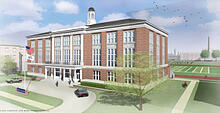Your next school building may look quite different than anything you have previously experienced. From the outside it could be designed to last a few centuries, but the inside will allow flexible use of the space for individual, small group, and even large group learning.
Last week we hosted the School Growth Lab at Roam, a co-working space for entrepreneurs in north Atlanta. As usual, the participants marveled at the creativity of the meeting rooms being used for a wide variety of learning experiences. The energy of the place is contagious, with people working on a myriad of different strategies to build their respective businesses--some of which include education-related services for new levels of innovation. Such co-working spaces offer a model for your next building.
How will your next building be different?
 It will look much more like a place for business startups. Teachers will be given the autonomy to more efficiently use time and learning spaces to more effectively support each student. Scheduling will be student-centered, as will instruction. Architects like Cornice & Rose are creating beautiful campus designs that maximize sustainability and profitability. That's a huge advantage in an increasingly competitive school market place.
It will look much more like a place for business startups. Teachers will be given the autonomy to more efficiently use time and learning spaces to more effectively support each student. Scheduling will be student-centered, as will instruction. Architects like Cornice & Rose are creating beautiful campus designs that maximize sustainability and profitability. That's a huge advantage in an increasingly competitive school market place.
It will be focused on cutting expenses, running a lean operating model. The best innovations happening in schools are often outside the classroom, with a focus on improving the operational efficiency of the organization. Simplifying the complexities of running a school or district through more entrepreneurial techniques can focus more resources on the students--who need it the most.
It will have flexible work spaces that are driven by instructional strategy rather than systematic compliance. Advances in furnishings and interior design allow administrators and teachers to be far more strategic in how learning experiences are created. Certain higher ed institutions are leading the way in work space innovation, and more K12 schools are capitalizing on this success.
It will feature video conferencing to connect multiple classrooms and students. This technology has made big advances over the last few years, but the biggest challenge is coordinating the schedule of classes to align across locations. Associations will play a larger role in negotiating these time issues to increase the number of online, collaborative learning opportunities.
It will include a production staff to collect data and produce high-quality materials that can leverage multiple revenue streams.
If you want to see what your next school building might look like, go visit a co-working space near you. Then sign up for our next School Growth Lab to experience the transformative effect of rapid innovation and improvement.


